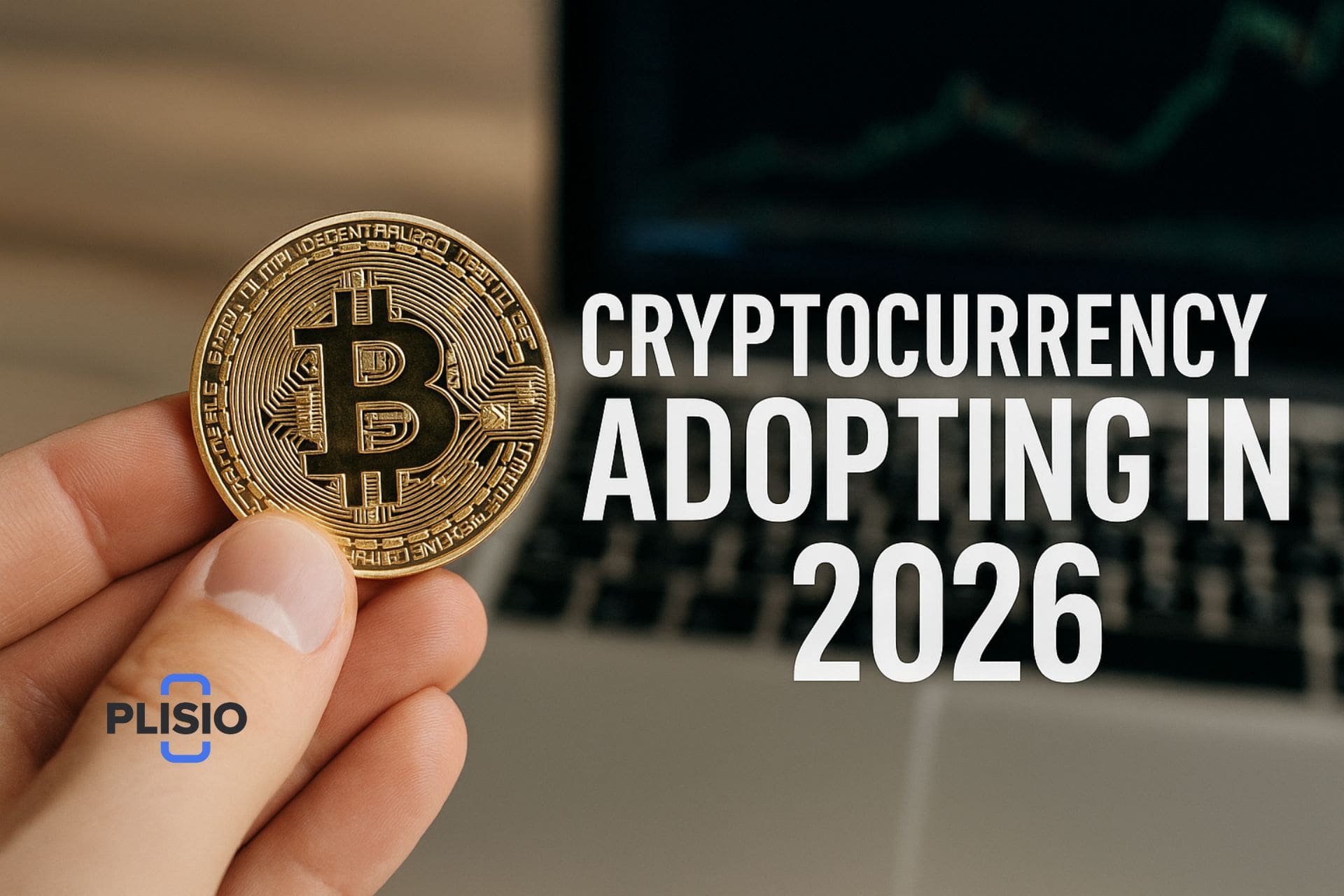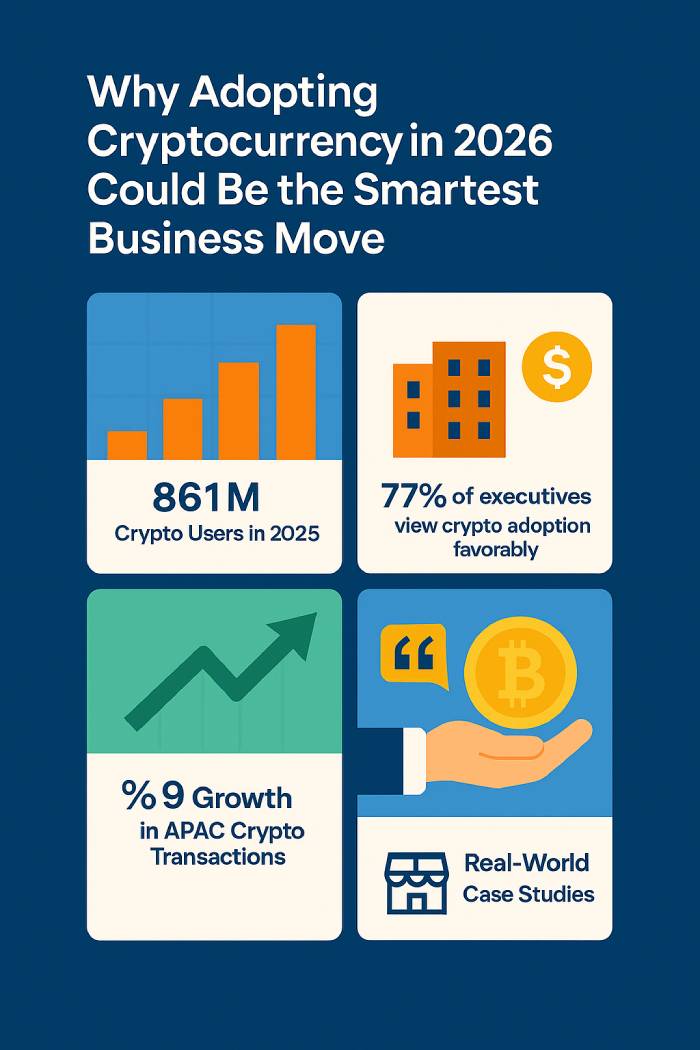Why Adopting Cryptocurrency in 2026 Could Be the Smartest Business Move

Cryptocurrency is no longer an experimental technology. It has evolved into a practical business tool — one that’s transforming how companies handle payments, reduce costs, and expand globally. For any business exploring new opportunities, ignoring this shift is no longer an option.
By 2026, more industries will begin to see crypto as a viable choice rather than a novelty. The change is already underway, and only the businesses that act now will lead the next phase of innovation. This is not just about following a trend — it’s about building a strategy that combines efficiency and flexibility.
Today, the advantage belongs to those who are prepared, not those who are merely curious. Adopting cryptocurrency is no longer optional — it’s a question of competitiveness.
Cryptocurrency Adoption Is Accelerating
The crypto world has moved far beyond the experimental phase. It’s now a functional part of real-world business operations, making transactions faster, cheaper, and more transparent. From payments and remittances to data tracking, crypto outperforms traditional systems — especially for companies involved in international trade.
As of 2025, global cryptocurrency adoption continues to surge:
- Over 861 million people worldwide are expected to use cryptocurrencies, representing 11% of the global population — up from just 420 million in 2022.
- The Asia-Pacific region saw a 69% year-over-year increase in on-chain activity between 2024 and 2025.
- In developed markets, crypto ownership has risen to 22% in the U.S., 24% in the U.K., and 21% in France, marking steady growth across mature economies.
Dr. Alicia Turner, Senior Analyst at Fintech Global, notes: “The adoption curve we’re witnessing now is similar to the early days of the internet. Businesses that integrate crypto early are positioning themselves at the forefront of digital commerce.”
Businesses are recognizing these benefits and adapting quickly. Real-time payments, low transaction fees, and verifiable records are now being integrated into everyday workflows. The result? Lower operational costs and higher customer trust. A single system upgrade can revolutionize how a business operates.
A powerful example comes from ShopSmart Asia, which integrated crypto payments in late 2024. Within six months, the company reported a 32% increase in international sales and a 45% reduction in transaction costs.
One clear example of this momentum is the rise of meme coins. What began with Dogecoin has expanded to projects like Bitcoin Hyper ($HYPER), Maxi Doge ($MAXI), and PepeNode ($PEPENODE). What once looked like a passing fad has evolved into a serious asset class with growing investor interest. At this pace, crypto is steadily establishing its place in the broader economy.
Ethan Park, Market Strategist at Chainalytics, comments: “We’re seeing a maturing market. The liquidity, infrastructure, and institutional interest behind these tokens are what make 2025–2026 a tipping point for mainstream adoption.”
If the current trend continues, by 2026, many industries will treat crypto as a standard payment and asset option. Companies that hesitate will find themselves falling behind — while those who adapt will seize new opportunities.

Real Cost Savings and New Revenue Streams
Take international remittances as an example. Traditional banking systems can take days and charge hefty fees, but with crypto, transfers are completed in minutes and at a fraction of the cost.
According to 2025 data from Chainalysis, global cross-border crypto transactions grew by 58% year over year, as businesses sought faster and cheaper alternatives to SWIFT transfers. The average cost of sending money internationally dropped from around 6.3% via banks to under 1% using blockchain-based payments.
Maria Delgado, CFO of CrossPay Solutions, explains: “We reduced our remittance processing time from three days to fifteen minutes after implementing blockchain payments. The impact on cash flow management was immediate.”
Tokenized assets also open new doors for businesses. Products can now be sold in digital form, allowing users to buy, sell, or trade ownership easily. This model fits perfectly with resale markets and sharing economy services — and it’s already growing too big to ignore. The global blockchain market is projected to reach $55.5 billion by the end of 2025, driven by enterprise adoption.
Additionally, many companies now view cryptocurrency as a hedge against inflation. Bitcoin remains the most widely held digital asset, accounting for 49% of total crypto market capitalization as of mid-2025. Some corporations are adding Bitcoin or stablecoins to their balance sheets as part of long-term risk management strategies.
James Liu, Head of Digital Assets at Horizon Capital, adds: “Holding digital assets gives companies flexibility. They’re not just hedging inflation — they’re also preparing for a new financial paradigm.”
The Next Step: Evolving Technology
Blockchain technology ensures transparency and trust by making transaction records immutable and publicly accessible. In industries where traceability matters — such as supply chain management — this capability is transformative. Companies can track issues and bottlenecks in real time.
From a security standpoint, blockchain is harder to breach than centralized systems. In 2025, the number of major corporate data breaches dropped by 27% among organizations using decentralized verification systems. In an era of frequent data leaks, this gives businesses a serious reputational advantage. Privacy-focused coins also allow companies to comply with data protection laws while maintaining operational speed.
Beyond today’s systems, Layer 2 scaling solutions like Lightning Network and central bank digital currencies (CBDCs) are emerging as major trends. These technologies are expected to make blockchain payments even faster and more energy-efficient by 2026.
Sophie Andersen, Chief Technology Officer at SecureChain Labs, notes: “Blockchain’s immutability and distributed nature make it inherently resilient. For businesses handling sensitive data, that’s a security upgrade money can’t easily buy.”
Broader Markets, Stronger Customer Engagement
Modern consumers value experiences as much as products. Brands that understand this are building deeper loyalty — and crypto is helping them do it.
Since crypto payments are borderless, there’s no need for currency exchange or long waits. Anyone with a smartphone can participate, including users in developing regions. That means a naturally expanding global market. In fact, according to the World Bank, over 1.4 billion adults remain unbanked, yet 70% of them own smartphones, making crypto a natural solution for financial inclusion.
A 2025 survey by Deloitte found that 64% of global consumers are more likely to trust a brand that accepts crypto payments — a clear sign that digital assets are reshaping expectations.
Nina Patel, Marketing Director at TokenHub, explains: “Crypto lets brands connect directly with global communities. We’re seeing fan-driven ecosystems where engagement feels authentic — it’s collaboration, not advertising.”
Moreover, crypto-powered communities are driving new marketing ecosystems. Through NFTs and branded tokens, companies can build long-term relationships with customers. Fans promote the brand organically, creating engagement that traditional ads can’t replicate.
Risks Exist, But Prepared Businesses Can Handle Them
Volatility is real, but it’s not insurmountable. Businesses can mitigate it by using stablecoins for transactions, ensuring steady cash flow even in fluctuating markets. Many global corporations are already using this approach. As of 2025, stablecoins account for over 70% of all on-chain transaction volume, underscoring their importance in reducing market risk.
As for technical complexity — that barrier is fading fast. Businesses no longer need to build crypto systems from scratch. With third-party solutions, user-friendly dashboards, and plug-and-play APIs, integration is simpler than ever. With some internal training, even teams without dedicated developers can get started.
Dr. Leon Meyer, Professor of Financial Technologies at Zurich Business School, comments: “The infrastructure layer has matured. The complexity that scared off small businesses five years ago is now handled by service providers.”
The key is balance. Rather than switching everything to crypto overnight, companies can operate hybrid systems that combine traditional and blockchain-based methods — gaining both stability and flexibility.
The Time to Act Is Now
By 2026, cryptocurrency is likely to become a core part of business infrastructure — not just a tech experiment. Major companies are already preparing quietly, and some have started implementing crypto solutions.
Getting started is easier than it seems. You don’t need a full system overhaul — simply adding crypto payment options is a strong first step. Modern crypto payment APIs can seamlessly integrate with existing websites or POS systems.
Lara Chen, CEO of PlisioPay, concludes: “In 2026, adopting crypto won’t be innovation — it will be expectation. The businesses that prepare today will own tomorrow’s market.”
To get ahead, businesses should start exploring tools like PlisioPay APIs, joining pilot programs, or integrating small-scale crypto payments today. Early adopters won’t just keep up — they’ll lead.
How Plisio Helps Businesses Succeed
Plisio is helping thousands of companies simplify their transition into the crypto economy. Its payment gateway allows businesses to accept more than 15 cryptocurrencies, automate invoicing, and manage settlements seamlessly — all with fees as low as 0.5%. Plisio’s intuitive dashboard requires no coding knowledge, making it easy for small and medium enterprises to integrate digital payments quickly. The platform also supports instant conversions to fiat, minimizing exposure to volatility while keeping operations stable. With built-in analytics, compliance tools, and 24/7 support, Plisio empowers businesses to grow globally with confidence.
The future is coming fast. In 2026, the question won’t be “Should we use crypto?” — it will be “Why didn’t we start sooner?”
